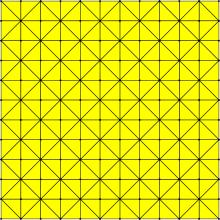| Tetrakis square tiling | |
|---|---|
 | |
| Type | Dual semiregular tiling |
| Faces | 45-45-90 triangle |
| Coxeter diagram | |
| Symmetry group | p4m, [4,4], *442 |
| Rotation group | p4, [4,4]+, (442) |
| Dual polyhedron | Truncated square tiling |
| Face configuration | V4.8.8 |
| Properties | face-transitive |
In geometry, the tetrakis square tiling is a tiling of the Euclidean plane. It is a square tiling with each square divided into four isosceles right triangles from the center point, forming an infinite arrangement of lines. It can also be formed by subdividing each square of a grid into two triangles by a diagonal, with the diagonals alternating in direction, or by overlaying two square grids, one rotated by 45 degrees from the other and scaled by a factor of √2.
Conway, Burgiel, and Goodman-Strauss call it a kisquadrille,[1] represented by a kis operation that adds a center point and triangles to replace the faces of a square tiling (quadrille). It is also called the Union Jack lattice because of the resemblance to the UK flag of the triangles surrounding its degree-8 vertices.[2]
It is labeled V4.8.8 because each isosceles triangle face has two types of vertices: one with 4 triangles, and two with 8 triangles.
- ^ Conway, John; Burgiel, Heidi; Goodman-Strauss, Chaim (2008), "Chapter 21: Naming Archimedean and Catalan polyhedra and tilings", The Symmetries of Things, AK Peters, p. 288, ISBN 978-1-56881-220-5
- ^ Stephenson, John, "Ising Model with Antiferromagnetic Next-Nearest-Neighbor Coupling: Spin Correlations and Disorder Points", Phys. Rev. B, 1 (11): 4405–4409, doi:10.1103/PhysRevB.1.4405.
